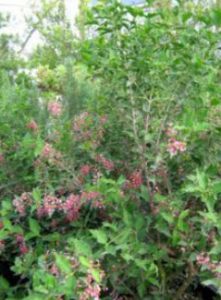
Dwarf Barbados Cherry (Malpighia glabra ‘Nana’), also known as Acerola or West Indian Cherry, is a compact shrub that produces small, glossy green leaves and delicate pink or white flowers. These blooms give way to bright red, cherry-like fruits that are edible and rich in vitamin C. The fruit has a sweet-tart flavor and is often used for juices, jams, or fresh consumption. The plant’s dense, dark-green foliage makes it an attractive choice for hedges, borders, or as a year-round accent in gardens.
History
Native to the West Indies, Central America, and parts of South America, the Barbados Cherry has been cultivated for centuries for its ornamental beauty and nutritional value. The dwarf variety, ‘Nana,’ was developed to provide a smaller, more manageable version of the plant, ideal for residential landscapes and container gardening.
Growing and Maintenance Tips
- Light: Prefers full sun but can tolerate partial shade.
- Soil: Thrives in well-draining soil and adapts to various soil types, including sandy or clay.
- Watering: Requires regular watering during establishment, but becomes drought-tolerant once mature.
- Temperature: In USDA zones 9–12, it thrives in warm, tropical climates.
- Fertilizer: Apply a balanced fertilizer in spring and summer to encourage growth and fruit production.
- Pruning: Prune lightly to maintain shape and remove dead or damaged branches. Heavy pruning can reduce flowering and fruiting.
- Pests and Diseases: Generally resistant to pests and diseases, though it may occasionally attract aphids or whiteflies.
The Dwarf Barbados Cherry is a versatile and low-maintenance plant that adds beauty and functionality to any garden. Its compact size makes it perfect for small spaces, and its fruit provides a delicious and nutritious treat.
